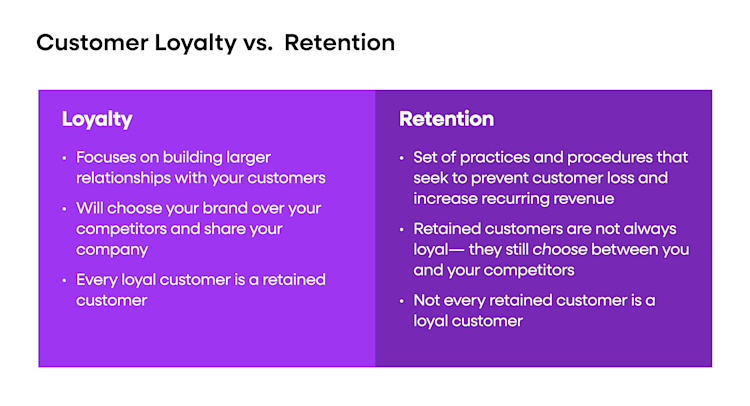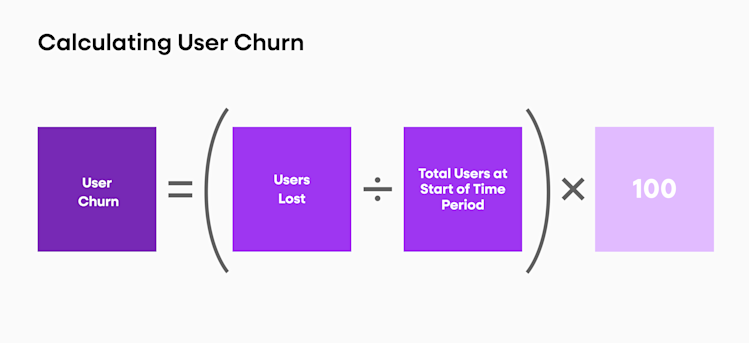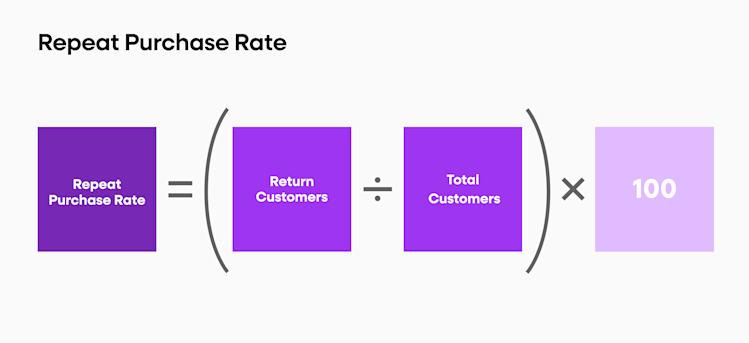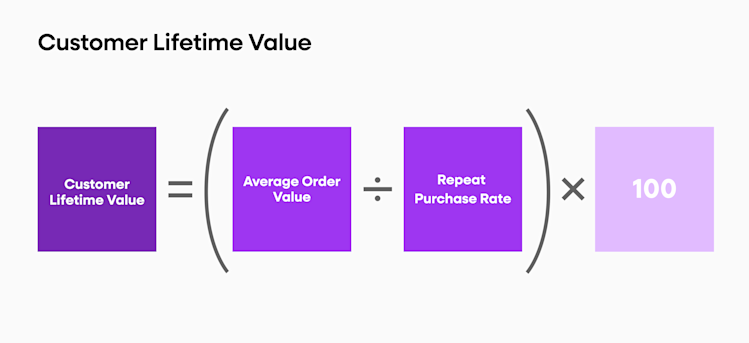If you’re working on an app or a website, understanding your user retention rate is essential. Without this information, it’s impossible to tell whether you’re on course for continued growth or whether you’re starting to lose users.
But how do you calculate retention rates, and why are they so important to your team's success? Here’s everything you need to know.
Key takeaways:
User retention rate measures the number of users who are continuing to use your app, website, or service after a given time period.
Customer retention rate (CRR) measures the percentage of paying customers a business maintains over a specific period, reflecting its ability to encourage repeat business.
Brands that want to increase their retention rate should identify at-risk customers and reach out to them before they turn elsewhere. They can use customer feedback to improve the customer experience and retain more users.
What is user retention rate?
User retention is when users or customers continue to use a product or feature. Therefore, user retention rate is the rate at which a platform retains its user.
In other words, user retention retention rate measures the number of users or customers a brand retains over a given time frame. This is written as a percentage of total customers who remained with the brand throughout the time period.
For example, if your app starts the month with 100 users and ends the month with 80, your app’s retention rate would be 80%.
In practice, it’s likely you’ll attract new users even as current active users drop off, which can cause your customer base to grow even with a low retention rate.
Let’s say your app started the month with 100 users. 20 users delete the app during the month, but 40 new customers sign up, leaving you with 120 users.
If you only used the raw number of customers, you’d have an app retention rate of 120% – a literal impossibility. You need to subtract the number of new customers from the end-of-month numbers to get an accurate calculation.
User retention rates are essential to projecting future growth. If your retention rate is higher than your rate of user acquisition, your customer base is growing. If it’s lower than your acquisition rate, your customer base is shrinking.
Finally—though user retention rate and customer loyalty are related, they are not the same thing.
Businesses use their retention rates to determine three things
What value are they providing to their existing customer base?
Is their customer base and rate of growth sustainable?
How loyal are their customers?
Some companies take an alternate approach. Instead of tracking their retention rate, they track their rate of customer churn/attrition.
How do you calculate user retention rate?
The formula for retention rate calculations is straightforward. First, you need to determine a given period of time to calculate over. Most companies measure customer retention on a monthly or annual basis. After that, you do the math:
User Retention Rate = [(CE - CN) / S] x 100
In this formula, CE is the number of users at the end of the time period, and CN is the number of users who signed up for subscriptions during the time period. S represents the number of users at the beginning of the time period.
Let’s do the math for our example above. Our hypothetical app had 100 users (S) at the beginning of the month, with 40 new users (N) and a total of 120 remaining (E) at the end of the month.
So the equation would be: [(120 - 40)/ 100 ] x 100 = 80%
Incidentally, our rate of new customer gain (40%) was less than our retention rate, which means that our growth is sustainable.
Why customer retention rate is so important to track
Customer retention rate is critical for businesses to understand their performance. Think of it like your users voting with their wallets. The higher your retention rate, the happier users are. On the other hand, a low customer retention rate tells you you’re off track.
The reason this is so powerful is that it gives you insight into customer sentiment that you can’t get by tracking other behaviors. People may lie on a customer service survey or ignore it altogether.
Customer retention rate can also be used to track customer reaction to changes in the service. For example, you could divide your customers into two cohorts. One cohort gets a major update to the app, while the other keeps using the old version.
By comparing the retention rates of the two cohorts, you could find out whether or not people liked the update. If they did, you can roll it out to all users. If they didn’t, you know it needs some more tinkering before it goes out. This kind of cohort analysis is key to many development strategies.
Learn more: Tracking user retention with Fullstory
What is a good user retention rate?
There’s no single percentage that qualifies as a “good” retention rate. Some types of mobile apps have low retention rates, and others have high ones. Look at retention rates for similar apps or companies and then use those digital product benchmarks to evaluate your own performance.
A lot depends on the nature of the app or service. A smartphone app takes some time and commitment to install. An ecommerce site, on the other hand, may see a lot of one-off orders.
Similarly, a new app or service should expect to see a lower retention rate. Many people will just be testing the waters at this phase, and won’t be as prone to sticking around. The important thing is to make adjustments and improve the rate over time.
Finally, it depends on what you’re trying to do with an app or service. If it’s a trial, you may not care about retention rate. If it’s something you’re trying to scale, retention rate will be very important indeed.
Retention rate vs. churn rate
Churn rate is the opposite of retention rate. Instead of calculating the percentage of customers who remain over time, you calculate the percentage who leave.
Compared to user retention rates, churn rates are easy to calculate. You just use the following formula:
Customer Churn Rate = (C / S) x 100
In this formula, C is the number of churned users and S is the number of users at the start of the month.
Let’s plug in the numbers we used in our earlier example:
(20 / 100) x 100 = 20%. Our brand has a 20% churn rate.
Like most inverses, churn rate doesn’t tell you anything new. It’s just another way of expressing the same information: 80% of users have stayed, and 20% have left.
Other key customer retention metrics
Besides retention rate and churn rate, there are many other important metrics that you should be aware of. Let’s go over the most significant.
Revenue churn
Revenue churn is a measure of how much recurring revenue you’ve lost across a particular time period. This is similar to customer churn in that it represents a loss, but it’s different because it doesn’t count individual users—it counts dollars.
Revenue churn isn’t always the strongest performance signal. For example, retail businesses expect to earn less money in January and February than during the holidays, so revenue churn isn’t necessarily a sign of poor performance.
But in other cases, it can be incredibly powerful. SaaS companies with tiered pricing models rely on revenue churn to account for downgrades. If a bunch of customers move from the “Platinum” tier to the “Silver” tier, there is no loss of customers. But the loss of revenue could be very significant.
Along the same line, low revenue churn could put high customer churn into context. If you’re keeping your most valuable customers and losing the ones who spend less, your business model may still be viable.
Net Promoter Score
Net promoter score (NPS) is a metric for tracking customer sentiment. A brand asks customers to answer a single question. On a scale from 1 to 10, how likely are they to recommend a product, service, or company?
Respondents are then sorted into three categories. “Promoters” are the most enthusiastic, and give ratings of 9 or 10. People who provided ratings of 7 or 8 are considered “passive,” while anyone who answers 6 or less counts as a “detractor.”
All of the results are aggregated, and the average number is the NPS score. This gives you a quick snapshot of how your customers feel. You can also ask a similar question for a particular aspect of your business, such as the onboarding experience.
Keep in mind that NPS scores may skew negative. Angry customers are more likely to answer a survey than satisfied ones.
Repeat purchase rate
Repeat purchase rate (RPR) is the percentage of customers who make a second purchase from your company. The formula is very simple:
Repeat Purchase Rate = (R / C) x 100
R represents the number of return customers, while C represents the number of total customers.
If you want to go even further, you can calculate the customer loyalty rate. This is the percentage of people who made even more purchases – exactly how many is up to you.
Finding your most loyal customers can help you pinpoint marketing to those people. You can also look at what features those customers are using, and see if you can drive other users to those features, as it might indicate low user friction.
Customer lifetime value
Customer lifetime value (CLV) is exactly what it sounds like. It’s a measure of how much profit your average customers contribute to your business over their lifetimes.
This is a tough number to measure, and you can only ever get an estimate. Without a crystal ball, there’s no way to know for sure how much someone will spend with your brand in the future.
There are also several calculations. One of the most popular is:
Customer Lifetime Value = (O x R) - C
In this equation, O represents the average order value, and R is the repeat purchase rate. C is the customer acquisition cost. That’s how much you spend in marketing and other expenses to gain the average customer.
Knowing your CLV can be useful when trying to decide how much to spend on customer retention. If your CLV is $100, it doesn’t make sense to offer a one-time signup bonus of $150.
How to improve user retention rate
Implementing best practices to increase user retention rate if often business critical. When analyzing ways to make improvements, always be sure to analyze both qualitative and quantitative data to ideate solutions. A few top tips include:
Make your onboarding UI as simple as possible
Build a straightforward, intuitive user interface
Use cohort analysis to test major updates
Send prompts to inactive users to get them to return
Survey churned users to find out why they left
Make continuous improvements and bug fixes
Use hooks and gamification to keep users engaged
Using Fullstory to improve user retention rate
Product analytics and Digital Experience Intelligence platforms like Fullstory help companies easily track their user retention and understand why users are leaving or staying. Using heatmaps, session replay, and more, these platforms give you a direct line into what your customers are seeing, what they like, and what they don’t like.
If you’re a free trial user looking to track your user retention rates in Fullstory, refer to our Fullstory Cookbook page for a quick setup how-to. And here’s how to configure retention charting in the Fullstory app.
Looking to better understand your users so they stick around? Start a free trial today.








